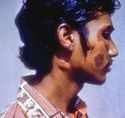Hesperian Health Guides
Checking Children for Signs of Leprosy
HealthWiki > Disabled Village Children > Chapter 26: Leprosy: Hansen’s Disease > Checking Children for Signs of Leprosy
EARLY SIGNS
A slowly growing patch on the skin that does not itch or hurt. The patch may be somewhat different in color from the surrounding skin. (Patches of leprosy are never completely white, and are not scaly, except during a reaction.)
Note: In early skin patches, feeling is often unaffected. If feeling is clearly reduced inside a patch, leprosy is almost certain.
What to look for
Examine the whole body for skin patches, especially the face, arms, back, butt, and legs.
 |
If you find a slightly pale patch without a clear edge, keep watching the spot. Unless feeling is reduced inside the patch, look for other signs before deciding it is leprosy. (Many children have similar pale spots on cheeks and arms that are not leprosy. |  |
| ringworm-like patches, with or without raised border |
LATER SIGNS
| 1. Tingling, numbness, or some loss of feeling in the hands and feet. Or definite loss of feeling in skin patches. TEST INSIDE THE SKIN PATCHES FOR REDUCED FEELING. With the tip of a feather or stiff thread, lightly touch the skin inside and away from the patch and have the child tell you (without looking) where he feels the touch. | |||
| If the child cannot feel the thread, try lightly touching the skin with a cotton swab dipped in rubbing alcohol (so it will feel cold), or the bottom of a test tube that contains very warm water. When using a warm object, test it on your own skin before touching the child's skin to avoid burning the child. |
 I feel it here. |
||
| 2. Slight weakness or deformity in the hands and feet. | ||

drop foot (Child cannot raise it.)
weakness or clawing of toes | ||
| Have the child straighten her fingers. If she cannot do this, it may be a sign of paralysis from leprosy. | Also have the child try to touch the base of her little finger with her thumb. |  |
Muscle weakness here makes this movement difficult and may be a sign. | |
 |
 | |||
|
CAUTION! These weaknesses may also be caused by polio, muscular dystrophy, or other conditions. | ||||
| 3. Enlargement of certain nerves, with or without pain or tenderness. The affected nerve feels like a thick cord under the skin. When they are quite thick, they may be easily seen. | ||||
 |
Check for large nerves in these places. |  |
Also check for large nerves in or near skin patches. | |
| thickening nerve below the ear (from A Manual of Leprosy). | ||||


